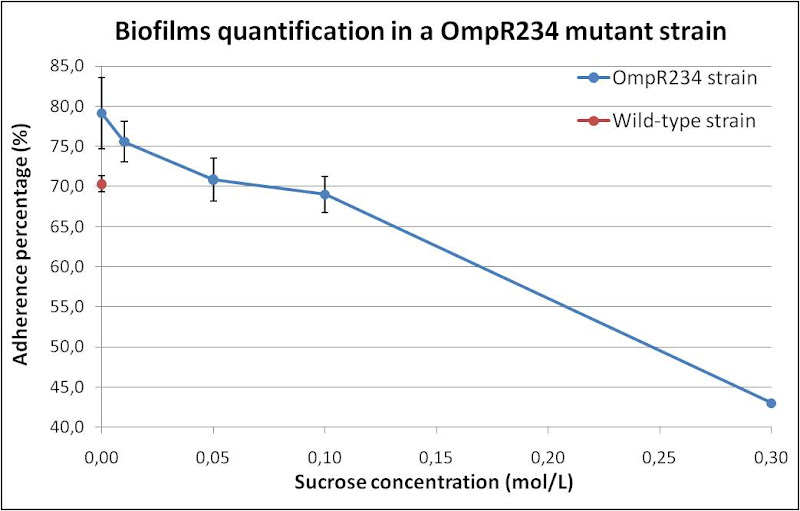Difference between revisions of "Part:BBa K342003:Experience"
(→Applications of BBa_K342003) |
|||
| Line 1: | Line 1: | ||
| − | |||
__NOTOC__ | __NOTOC__ | ||
This experience page is provided so that any user may enter their experience using this part.<BR>Please enter | This experience page is provided so that any user may enter their experience using this part.<BR>Please enter | ||
| Line 5: | Line 4: | ||
===Applications of BBa_K342003=== | ===Applications of BBa_K342003=== | ||
| + | <html> | ||
| + | |||
| + | <h3><font color="purple">OmpR234 characterization</font></h3> | ||
| + | |||
| + | <div style="text-align:center; float:right; margin-left:30px; margin-top:-20px;"> | ||
| + | <img src="http://lh5.ggpht.com/_Uc3bmii-yi0/TMjSI5MN6jI/AAAAAAAAAs4/36no5Ec9rZg/s800/quantif%20biofilms.jpg" style="width:460px; height:240px; margin-top: 10px; margin-bottom: 5px; position: relative;"/> | ||
| + | </div> | ||
| + | |||
| + | <p> We managed a quantification of biofilms formation of a mutant OmpR234 strain (PHL818 chassis, more explained above), versus a wild-type strain (MG1655), at 30°C, in a 24-well hydrophobic polystyrene maden plate. Optimal condition to observe biofilms is a growth in minimal medium (M63/2), supplemented with a carbon source (glucose 0,2g/L). We modified osmotic pressure by varying sucrose concentration (between 0 and 0,3 mol/L). The purpose of this experiment is to make in evidence the osmolarity influence on the capacity to OmpR234 to induce Curli adherent structures.<br><br> | ||
| + | </p> | ||
| + | |||
| + | <p>As we can see, a decreasing adherence percentage of OmpR234 mutant is observed (about 40%), while the osmotic pressure is decreased (increasing medium osmolarity). The most important biofilm formation is seen without any osmolyte (sucrose 0 mol/L). We tested the wild-type strain for adherence without sucrose. We observed that the OmpR234 mutation induced a slight increase in biofilm formation (about 7%). This experiment is a preliminary characterisation of our OmpR234 BioBrick, as the part was designed from this genomic mutant protein (see <a href="http://2010.igem.org/Team:INSA-Lyon/Project/Stage3/Strategy/Designcurli#ompr">Design of OmpR234</a>).<br> | ||
| + | |||
| + | Thus, we expected to have a higher effect with a high-copy plasmid containing our OmpR234 BioBrick (under a constitutive promoter for example). | ||
| + | </p> | ||
| + | |||
| + | <div style="text-align:center;"> | ||
| + | <!-- <img class="image" src="" /> --> | ||
| + | <!-- <img class="image1" src="" /> --> | ||
| + | </div> | ||
| + | </html> | ||
===User Reviews=== | ===User Reviews=== | ||
Revision as of 20:40, 1 November 2010
This experience page is provided so that any user may enter their experience using this part.
Please enter
how you used this part and how it worked out.
Applications of BBa_K342003
OmpR234 characterization

We managed a quantification of biofilms formation of a mutant OmpR234 strain (PHL818 chassis, more explained above), versus a wild-type strain (MG1655), at 30°C, in a 24-well hydrophobic polystyrene maden plate. Optimal condition to observe biofilms is a growth in minimal medium (M63/2), supplemented with a carbon source (glucose 0,2g/L). We modified osmotic pressure by varying sucrose concentration (between 0 and 0,3 mol/L). The purpose of this experiment is to make in evidence the osmolarity influence on the capacity to OmpR234 to induce Curli adherent structures.
As we can see, a decreasing adherence percentage of OmpR234 mutant is observed (about 40%), while the osmotic pressure is decreased (increasing medium osmolarity). The most important biofilm formation is seen without any osmolyte (sucrose 0 mol/L). We tested the wild-type strain for adherence without sucrose. We observed that the OmpR234 mutation induced a slight increase in biofilm formation (about 7%). This experiment is a preliminary characterisation of our OmpR234 BioBrick, as the part was designed from this genomic mutant protein (see Design of OmpR234).
Thus, we expected to have a higher effect with a high-copy plasmid containing our OmpR234 BioBrick (under a constitutive promoter for example).
User Reviews
UNIQ51ae40505a0211c7-partinfo-00000001-QINU UNIQ51ae40505a0211c7-partinfo-00000002-QINU
